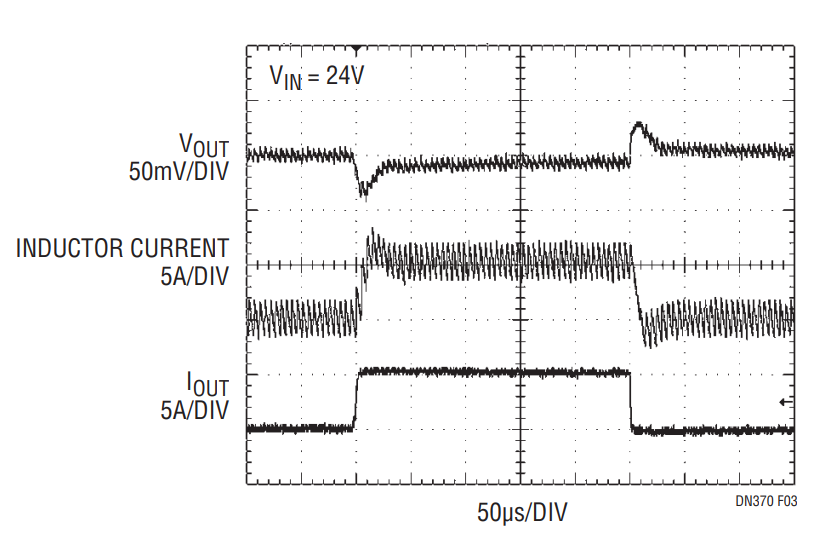Design Note 370: Buck or Boost: Rugged, Fast 60V Synchronous Controller Does Both
Introduction
Automotive, telecom and industrial systems are harsh, unforgiving environments that demand robust electronic systems. For example, an automotive battery system may be a nominal 12V, 24V or 42V, but load dump conditions can generate transients up to 60V. The LTC3703-5 is a synchronous switching regulator controller that can directly step down input voltages up to 60V and withstand transients up to 80V, making it ideal for harsh environments. The ability to step down the high input voltage directly allows a simple single inductor topology, resulting in a compact high performance power supply—in contrast to the low side drive topologies that require bulky, expensive transformers.
Feature Rich Controller
The LTC3703-5 drives external logic-level N-channel MOSFETs using a constant frequency, voltage mode architecture. A high bandwidth error amplifier and patented line feed forward compensation provide very fast line and load transient response. Strong 1Ω gate drivers minimize switching losses—often the dominant loss component in high voltage supplies—even when multiple MOSFETs are used for high current applications. Other features include:
- Low minimum on-time (200ns) for low duty cycle applications
- Precise 0.8V ±1% reference
- Programmable current limit utilizing the voltage drop across the synchronous MOSFET to eliminate the need for a current sense resistor
- Programmable operating frequency (100kHz to 600kHz)
- Low shutdown current (25μA), external clock synchronization input and selectable pulse skip mode operation
- Packaged in a 16-pin narrow SSOP or a 28-pin SSOP if high voltage pin spacing is desired.
High Efficiency 48V to 3.3V/6A Power Supply
The circuit shown in Figure 1 provides direct stepdown conversion of a typical 48V telecom input rail to 3.3V at 6A.The circuit can handle input transients up to 60V without requiring protection devices or 80V if appropriate MOSFETs are used. The frequency is set to 250kHz to optimize efficiency and output ripple. Figure 2 shows a mid-range efficiency of over 90% at 24V input and 83.5% at 48V input. The loop is compensated for a 50kHz crossover frequency which provides 20μs response time to load transients (see Figure 3). The outstanding line transient performance is shown in Figure 4. The 12.1k RMAX resistor value is chosen to limit the inductor current to about 12A during a short-circuit condition.

Figure 1. Buck: 48V to 3.3V/6A Synchronous Step-Down Converter.

Figure 2. Efficiency of Figure 1’s Circuit.

Figure 3. Load Transient Performance of Figure 1 Circuit Shows 20μs Response Time to 5A Load Step.

Figure 4. Line Transient Performance of Figure 1 Circuit Shows Almost Complete Rejection of 12V to 50V Supply Transient.
High Efficiency 12V to 24V/5A Synchronous StepUp Fan Power Supply
Synchronous boost converters have a significant advantage over non-synchronous boost converters in higher current applications due to the low power dissipation of the synchronous MOSFET compared to that of the diode in a non-synchronous converter. The high power dissipation in the diode requires a much larger package (e.g. D2PAK) than the small S8-size package required for the synchronous MOSFET for the same output current.
Figure 5 shows the LTC3703-5 implemented as a synchronous step-up converter for generating 24V/5A from 12V—a common voltage for driving fans. This supply achieves a peak efficiency over 96% (see Figure 6). The LTC3703-5 is set to operate as a synchronous boost converter by simply connecting the INV pin to greater than 2V. In boost mode, the BG pin becomes the main switch and TG becomes the synchronous switch. Aside from this phase inversion, boost mode operation is similar to buck mode. In boost mode, the LTC3703-5 can produce output voltages as high as 60V.

Figure 5. Boost: 12V to 24V/5A Synchronous Step-Up for Fan Power Supply.

Figure 6. Efficiency of Figure 5’s Circuit.
